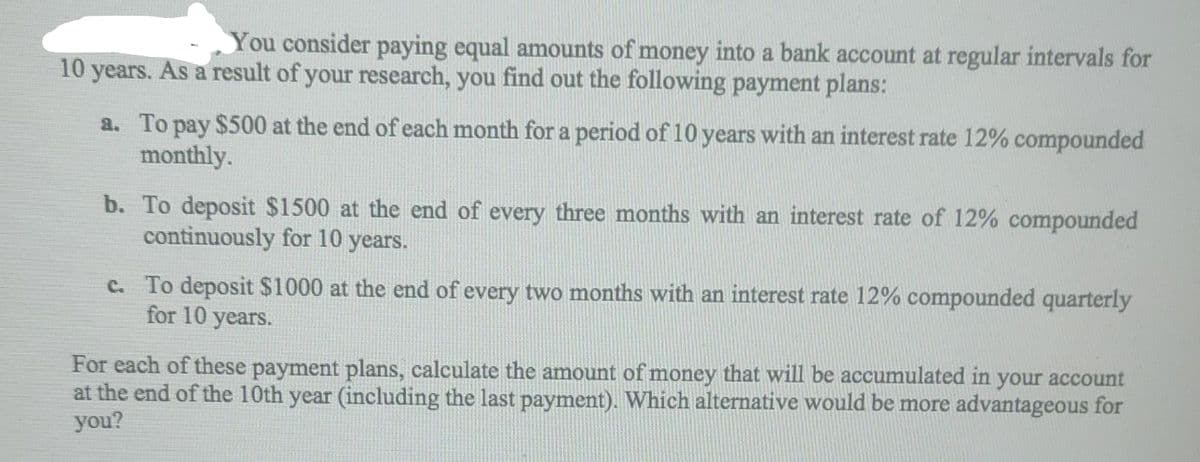You consider paying equal amounts of money into a bank account at regular intervals for 10 years. As a result of your research, you find out the following payment plans: a. To pay $500 at the end of each month for a period of 10 years with an interest rate 12% compounded monthly. b. To deposit $1500 at the end of every three months with an interest rate of 12% compounded continuously for 10 years. c. To deposit $1000 at the end of every two months with an interest rate 12% compounded quarterly for 10 years. For each of these payment plans, calculate the amount of money that will be accumulated in your account at the end of the 10th year (including the last payment). Which alternative would be more advantageous for you?
You consider paying equal amounts of money into a bank account at regular intervals for 10 years. As a result of your research, you find out the following payment plans: a. To pay $500 at the end of each month for a period of 10 years with an interest rate 12% compounded monthly. b. To deposit $1500 at the end of every three months with an interest rate of 12% compounded continuously for 10 years. c. To deposit $1000 at the end of every two months with an interest rate 12% compounded quarterly for 10 years. For each of these payment plans, calculate the amount of money that will be accumulated in your account at the end of the 10th year (including the last payment). Which alternative would be more advantageous for you?
Algebra and Trigonometry (6th Edition)
6th Edition
ISBN:9780134463216
Author:Robert F. Blitzer
Publisher:Robert F. Blitzer
ChapterP: Prerequisites: Fundamental Concepts Of Algebra
Section: Chapter Questions
Problem 1MCCP: In Exercises 1-25, simplify the given expression or perform the indicated operation (and simplify,...
Related questions
Topic Video
Question
Q4

Transcribed Image Text:You consider paying equal amounts of money into a bank account at regular intervals for
10 years. As a result of your research, you find out the following payment plans:
a. To pay $500 at the end of each month for a period of 10 years with an interest rate 12% compounded
monthly.
b. To deposit $1500 at the end of every three months with an interest rate of 12% compounded
continuously for 10 years.
c. To deposit $1000 at the end of every two months with an interest rate 12% compounded quarterly
for 10 years.
For each of these payment plans, calculate the amount of money that will be accumulated in your account
at the end of the 10th year (including the last payment). Which alternative would be more advantageous for
you?
Expert Solution
This question has been solved!
Explore an expertly crafted, step-by-step solution for a thorough understanding of key concepts.
Step by step
Solved in 4 steps with 4 images

Knowledge Booster
Learn more about
Need a deep-dive on the concept behind this application? Look no further. Learn more about this topic, algebra and related others by exploring similar questions and additional content below.Recommended textbooks for you

Algebra and Trigonometry (6th Edition)
Algebra
ISBN:
9780134463216
Author:
Robert F. Blitzer
Publisher:
PEARSON

Contemporary Abstract Algebra
Algebra
ISBN:
9781305657960
Author:
Joseph Gallian
Publisher:
Cengage Learning

Linear Algebra: A Modern Introduction
Algebra
ISBN:
9781285463247
Author:
David Poole
Publisher:
Cengage Learning

Algebra and Trigonometry (6th Edition)
Algebra
ISBN:
9780134463216
Author:
Robert F. Blitzer
Publisher:
PEARSON

Contemporary Abstract Algebra
Algebra
ISBN:
9781305657960
Author:
Joseph Gallian
Publisher:
Cengage Learning

Linear Algebra: A Modern Introduction
Algebra
ISBN:
9781285463247
Author:
David Poole
Publisher:
Cengage Learning

Algebra And Trigonometry (11th Edition)
Algebra
ISBN:
9780135163078
Author:
Michael Sullivan
Publisher:
PEARSON

Introduction to Linear Algebra, Fifth Edition
Algebra
ISBN:
9780980232776
Author:
Gilbert Strang
Publisher:
Wellesley-Cambridge Press

College Algebra (Collegiate Math)
Algebra
ISBN:
9780077836344
Author:
Julie Miller, Donna Gerken
Publisher:
McGraw-Hill Education